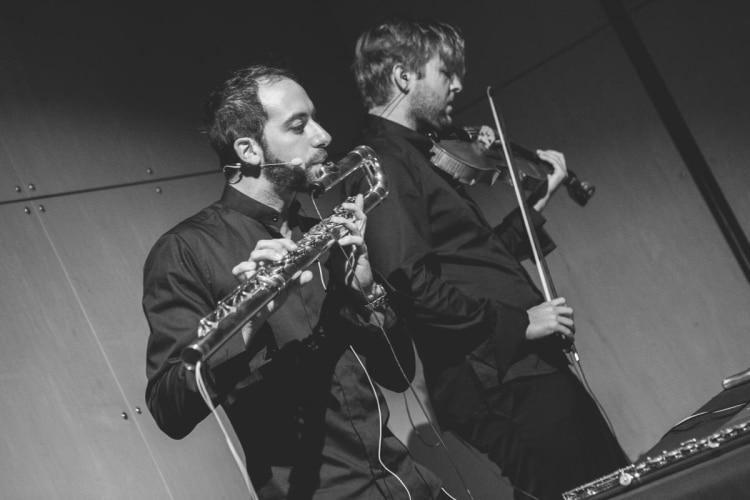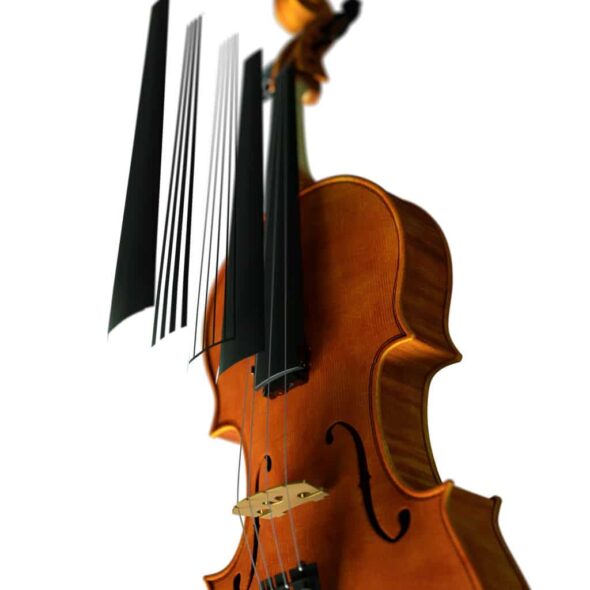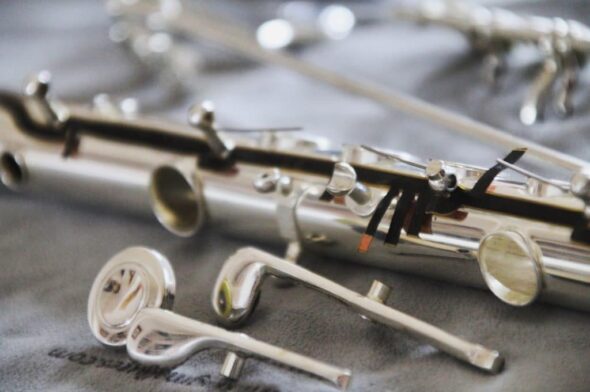
Mica Austria
NIMIKRY is the name of the composer-musician-developer duo, consisting of flautist ALESSANDRO BATICCI and violist RAFAL ZALECH. The two met in 2014 at the UNIVERSITY of MUSIC and PERFORMING ARTS in Vienna. Both studied electro-acoustic composition and are active as the duo NIMIKRY in contemporary music. During their studies however, BATICCI and ZALECH also began to develop extensions of their instruments. Their latest project is called “DigitAize”, which makes it possible to scan the violin, model its sounds and much more with the help of self-programmed software and a sensor pad. In an interview with Shilla Strelka, ALESSANDRO BATICCI explained why composers set out to find new ways of creating sound, how to go from being a musician to becoming an inventor and entrepreneur, what projects they already have been able to realize and the philosophy behind them.

“WE WANTED TO REDEFINE THE INSTRUMENT […]”
Rafal and you are composers and classically trained instrumentalists. A few years ago you took a bold step: You ventured into the development of new music technologies. More specifically, you are creating digital mapping systems for your instruments. At what point did it seem necessary to think beyond the boundaries of your instruments?
Alessandro Baticci: It was a compositional necessity to deal with the instrument in a new way. Advanced playing techniques, with which we were both familiar, were no longer sufficient. We wanted to redefine the instrument and create a meaningful coupling with electronics.
“‘DIGITAIZE’ MAKES IT POSSIBLE TO DIGITALLY CAPTURE STRING INSTRUMENTS IN A VARIETY OF WAYS”
The development you are alluding to is called “DigitAize”. It’s an extension for string instruments – a digital fingerboard that scans the instrument’s fingerboard with a sensor and controls a module that is linked to a software you developed. Could you explain how it works?
Alessandro Baticci: “DigitAize” makes it possible to digitally capture string instruments in many different ways. It forms an invisible bridge between the acoustic instrument and the computer. We use a self-developed sensor that is mounted over the instrument’s fingerboard. This sensor is linked to an electronic evaluation unit that processes and interprets the data and sends it wirelessly to the computer.
This makes many things possible, including real-time notation, control of synthesizers, monitoring of movements, evaluation of dexterity and many other applications.

In contemporary music there is an increasing tendency to develop extensions of classical instruments.
Alessandro Baticci: It’s now almost part of the nature of contemporary academic music that it deals with the expansion of instruments, either by extended playing techniques or by the inclusion of electronics. But exclusively searching for “the new” or “the unheard-of” can also be a chimera and at the same time a dead end. I would even go so far as to say that this tendency no longer stems from an actual musical necessity, but follows a trend, a mannerism that is typical of contemporary music.
“OUR PRIMARY CONCERN WAS NOT THE DEVELOPMENT OF NEW SOUNDS, BUT THE TRANSFER OF THE EXPRESSIVE POSSIBILITIES OF ACOUSTIC INSTRUMENTS INTO THE DIGITAL WORLD”
You are also expanding, but you have a different, more far-reaching agenda.
Alessandro Baticci: We are not primarily concerned with developing new sounds, but with transferring the expressive possibilities of acoustic instruments into the digital world. It’s about fundamental elements of composition: the control of electronic processes by the musical instrument and a better synthesis of electronic and instrumental sounds. The experience we have had with live electronics has driven us to look for new and better possibilities.
Why was it crucial for you to continue using your acoustic instruments and not to rely on purely digital options?
Alessandro Baticci: Although the current musical instruments market contradicts me, I maintain that in one or two generations it will be very difficult to deal with an acoustic musical instrument. The acceleration and the density of information with which we constantly strain our brain lead to a great lack of concentration and endurance. The school system is already confronted with the consequences today. There will be enough controllers and digital solutions to provide an instrument-like experience, but they will only require a fraction of the effort involved in mastering a classical musical instrument. Self-playing pianos and AI-based software are already contributing to the music consumption of a large mass of people.
Our technology expands the acoustic instrument and allows for it to live on in the future. It does not want to be a simplification of it. Moreover, this digital translation also requires a deeper acoustic exploration of the instrument. In this respect we can speak of a neo-humanistic mission. On the road to total digitalization, we are adding those areas that characterize us in our human nature and which are unique to us.
How did you proceed?
Alessandro Baticci: Innovations in instrument making have always initiated a lot of things. And in the last 200 years, apart from the electric violin, there has been no major change in the world of string instruments. Our technology makes it possible for the first time to digitize the acoustic instrument without having to make any compromises regarding playability. We have been working on the development of this system over the last five years, thinking about every aspect: playability, assembly, maintenance, feature, coupling, compatibility. How one uses it, is then up to each and every one. Our aim is to create the widest possible range of options.
“[…] LEARNING BY DOING IS OUR CREDO”
As a musician, how does one begin to move towards software and hardware development and to deal with such advanced technology as “DigitAize” requires? Was that a difficult process?
Alessandro Baticci: We were not aware of what was in store for us. We got involved in a complex process. We had to acquire a lot of knowledge: from 3D modeling to C programming, from designing to creating business models. We also rely on external experts in the respective sectors, but learning by doing is our credo.

At the same time you become researchers in your field. How did you go about it?
Alessandro Baticci: The empirical method is especially essential in the creative field. But the project covers many different fields of knowledge. It’s only to a limited extent about music. An important part is hardware and software development and programming. Of course we can’t do everything ourselves, but we set the direction. As an artist you are certainly advantaged, because you are used to follow your intuition. Rafal and I have learned that the work of a programmer is not unlike that of a composer. After all, in most cases there is not just one way to program something, but numerous, if not infinite ways. Of course, one follows criteria such as resource optimization, but there’s still enough leeway to leave your own imprint. In the end you create a small world, a microcosm. Isn’t that similar to composing?
“DIGITALIZATION IN OUR SOCIETY HAS SERIOUS CONSEQUENCES FOR MUSIC AS WELL”
Do you have the feeling that this kind of digital extension is a necessary step in contemporary music?
Alessandro Baticci: It is not about contemporary, classical or electronic music. Our current development is a necessary step in music, in instrument making, in art in general. In the small garden of one’s own artistic activity it is often difficult to see the bigger picture. The digitalization in our society has serious consequences for music as well. And here I want to put aside any kind of value judgement, and it’s not about categories like “good” and “bad”. I’m talking about a development that is changing our way of thinking, our languages, our human nature in general and with it inevitably our forms of expression.
If you analyze the development of the music industry in recent years, interesting conclusions can be drawn: All successful digital musical instruments and controllers are based on purely digital solutions. In contrast, the continuous development of acoustic musical instruments has been severely neglected, especially in the last century. In the process, one element that is important to us has been lost: the interaction with the acoustic instrument requires the development of fine-motor skills and this is an important source of creativity, expression and human authenticity in music. Our development wants to maintain this added value in the digital domain. Our technological extension redefines acoustic instruments anew.
Do composers too get involved in such technological extensions?
Alessandro Baticci: It remains a tool for instrumentalists. Composers can and will certainly use “DigitAize”, but first and foremost the musicians should benefit from it. Nowadays there are many instrumentalists in various genres who are creatively dealing with their instruments and who also compose, experiment, improvise and work with electronics themselves. The product is aimed precisely at these musicians.
I believe that in the future it will also find a broad application in the film music sector and in musicals. We also want to use our technology in the field of education. Here we see a great potential, especially in the visualization of motion sequences and the monitoring of intonation.
“DigitAize” is a tool for string instruments. Now, you are actually a flautist. Are you planning a version for flute as well?
Alessandro Baticci: Yes, in autumn we should be able to finalize the development of a version for flute. The system is based on the same module as the one for string instruments, but the data processing is radically different due to the different nature of the instruments. In the end, the goal is the same: to enable a digital representation of the instrument.

Do you plan to adapt “DigitAize” tools for a variety of different instruments?
Alessandro Baticci: We have many projects going on right now. As far as the further development of “DigitAize” is concerned, I see the greatest potential in its application in music education and in a profound synthesis of the instrument. The control of virtual sound sources and digital mapping can be infinitely enhanced by the inclusion of “physical modeling” or “machine learning”. This is a concrete vision for us.
Another idea you have implemented is the application “Audition Assistant”. What is that exactly?
Alessandro Baticci: “Audition Assistant” is a portal for classical musicians. It is intended as a practical training tool for instrumentalists, but it is much more than that. It offers professionally recorded accompaniments for the most important works of classical music. You have the possibility to change the playing tempo and the temperament without limits. This makes it possible to practice a piece really well. In addition, the app has a built-in mute device and metronome. It also offers the possibility to record oneself while playing and share the recording with friends. Thereby we want to initiate a new form of musical interaction and enable a stronger exchange between friends and classmates. After a long period of development we have just released the app “Cross-Platform” and are working on a major update which should be ready in autumn.
“I BELIEVE THAT MIXING DIFFERENT DOMAINS OF KNOWLEDGE IS THE ORIGIN OF NEW IDEAS”
You have to think in a parallel way on many levels. On one side you are a composer and musician, and on the other a developer and entrepreneur. How do you put all that together?
Alessandro Baticci: I believe that mixing different domains of knowledge is the origin of new ideas. I was fortunate to have been able to educate myself in very different disciplines, and I really enjoy this variety. This gives me the necessary motivation to work creatively.
I strongly assume that your inventions are also used when you appear as Nimikry?
Alessandro Baticci: Exactly. That was now and then the reason why we wanted to further develop the technology in this form. We were looking for new ways of expression for our instruments and have conceived a compositional idea that was not yet possible in this form. Now the development is completed and we have new tools to implement our compositional visions in a better way. Necessity is the mother of invention.

The Covid-19 crisis brings with it a performance ban for musicians. How did you deal with the quarantine period? I saw that you were working on a new project.
Alessandro Baticci: Of course, like all artists, I’ve experienced a major breakdown. I could actually feel a slowdown in my pace of life which also had positive aspects. But Rafal and I tried to devote ourselves to the further development of the projects and not to think too much about the consequences of the measures.
Personally, I was also able to complete a project that I have been working on for some time; during the quarantine I created a “sample library” of all my flutes: “Hyperflute”. With it I focused on the extended playing techniques of the instrument. I have also tried to integrate the notation of the playing techniques in order to establish a light, economical and uniform notation. The result is a massive tool for composers, arrangers or sound artists.
With so many different projects, do you still have time to devote yourself to music and composition?
Alessandro Baticci: Unfortunately the time for this is more limited. But I think that many of these projects have a positive influence on my compositional activity as well. Especially the creative applications of “DigitAize” have inspired me to make new experiments which in turn have an influence on my work. It’s a fruitful process.
Many thanks for the interview!
Shilla Strelka
Links:
Nimikry Music (Website)
Alessandro Baticci (Website)
DigitAize (Website)
Audition Assistant (Website) / (Google Play) / (Apple Store)
Translated from the German original by Julian Schoenfeld